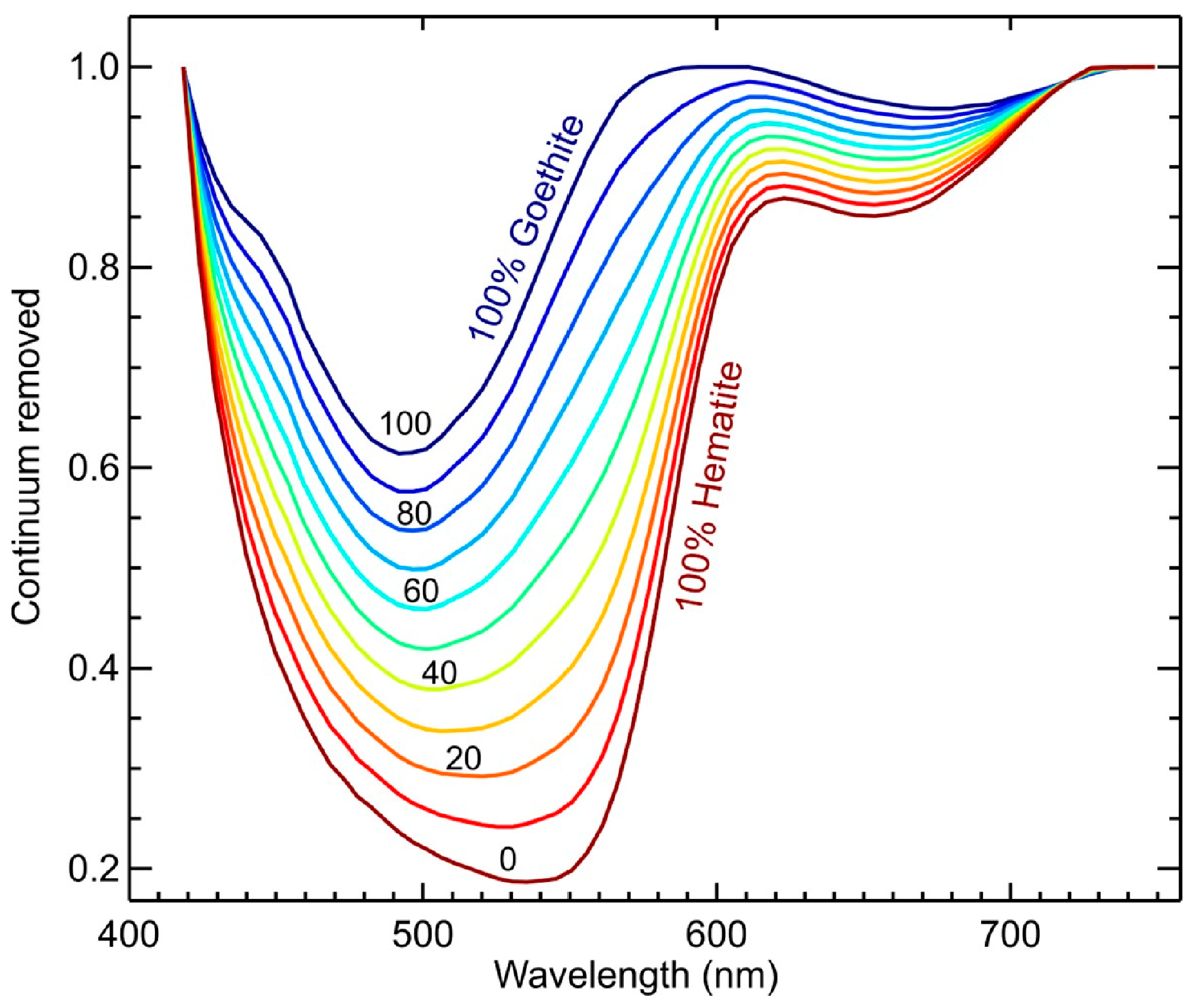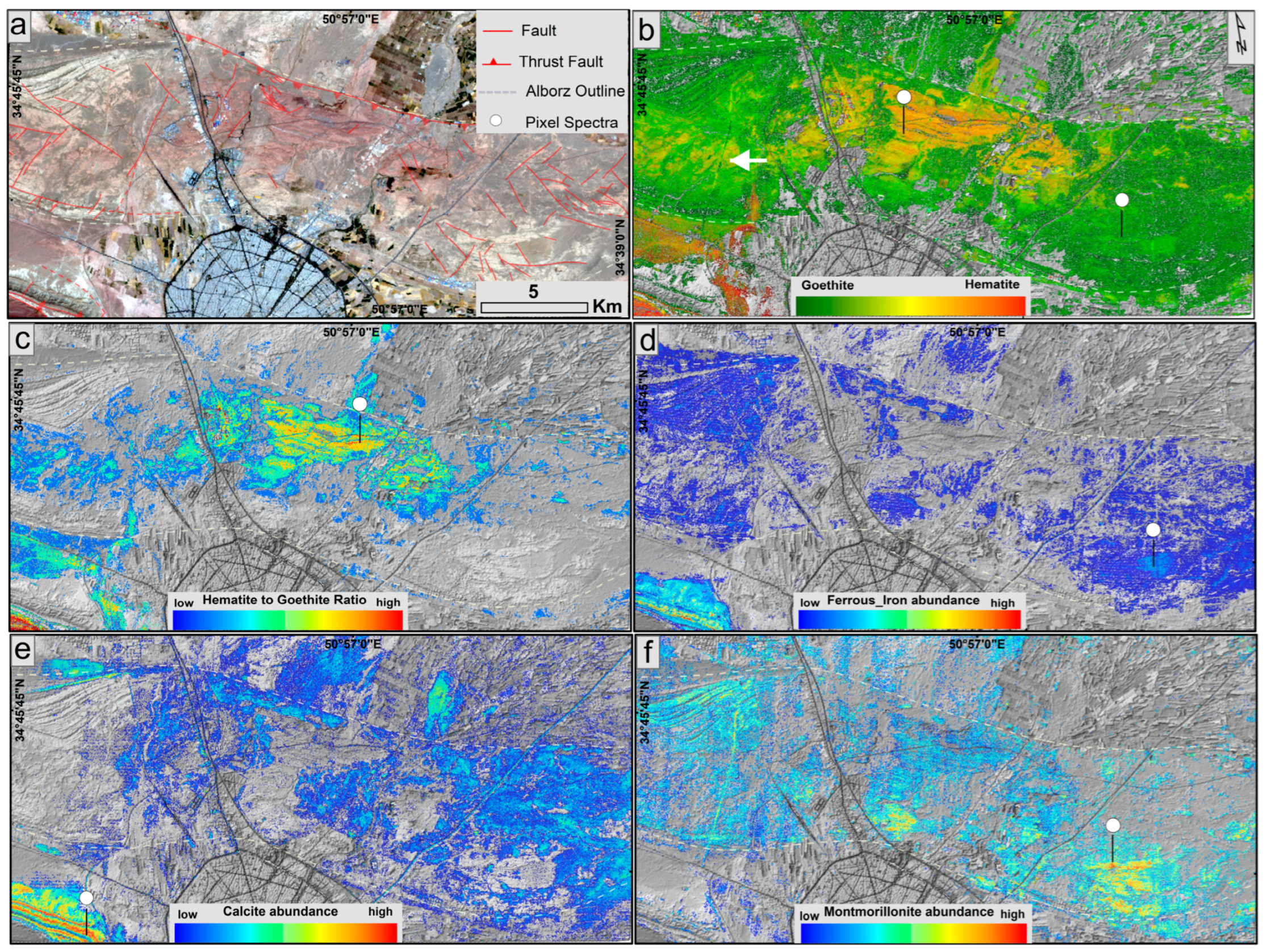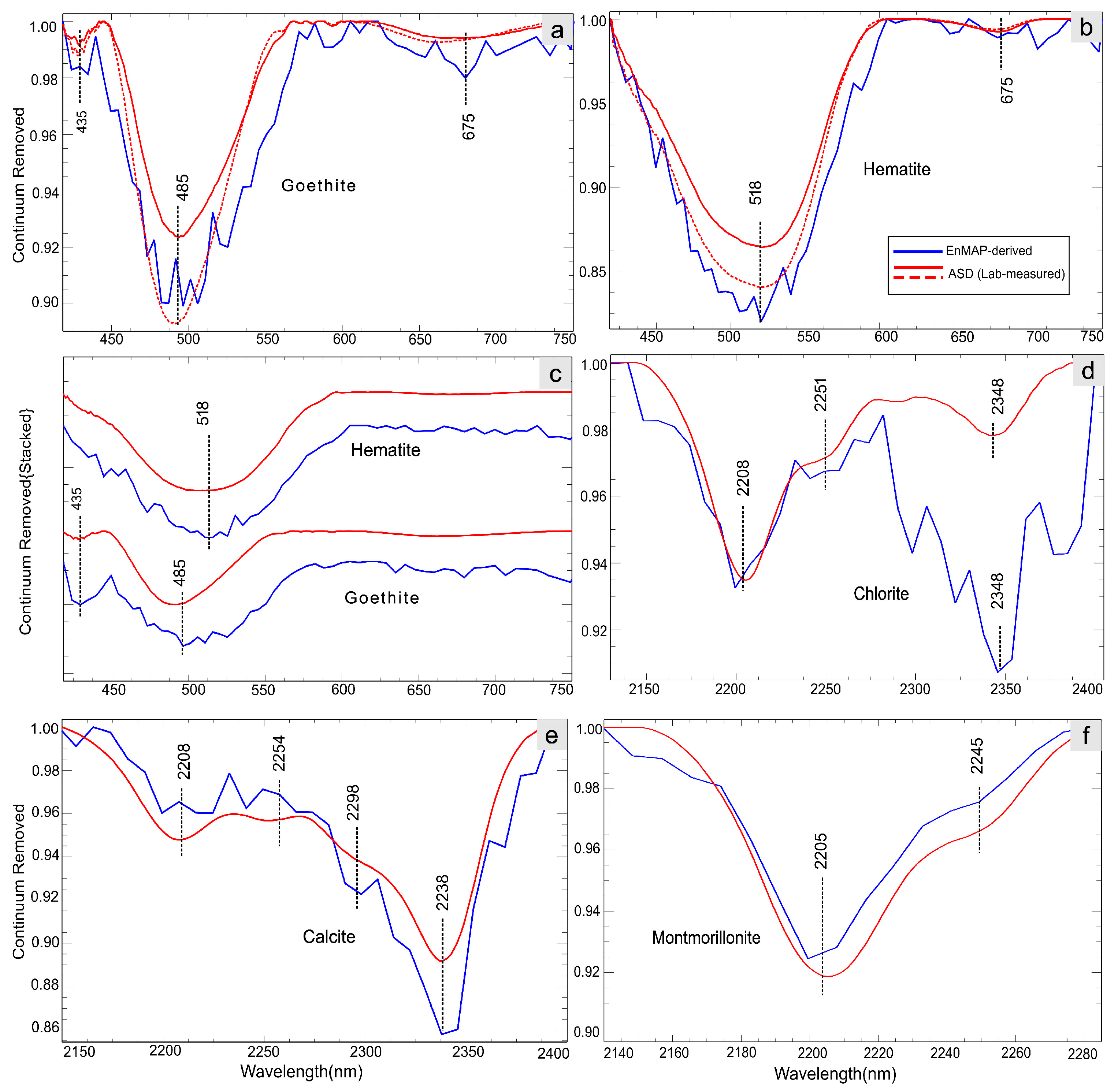Mapping the Mineralogical Footprints of Petroleum Microseepage Systems in Redbeds of the Qom Region (Iran) Using EnMAP Hyperspectral Data
Abstract
1. Introduction
2. Materials and Methods
2.1. Geologic Background
2.2. EnMAP Hyperspectral Data
2.3. Spectral Processing
2.4. Field Observations and Laboratory Spectroscopy
3. Results
4. Discussion
5. Conclusions
Supplementary Materials
Author Contributions
Funding
Data Availability Statement
Acknowledgments
Conflicts of Interest
References
- Saunders, D.F.; Burson, K.R.; Thompson, C.K. Model for hydrocarbon microseepage and related near-surface alterations. AAPG Bull. 1999, 83, 170–185. [Google Scholar] [CrossRef]
- Schumacher, D. Hydrocarbon-induced alteration of soils and sediments. AAPG Mem. 1996, 66, 71–89. [Google Scholar]
- Thompson, C.; Saunders, D.; Burson, K. Model advanced for hydrocarbon microseepage, related alterations. Oil Gas J. 1994, 92, 45–50. [Google Scholar]
- Al-Shaieb, Z.; Cairns, J.; Puckette, J. Hydrocarbon-induced diagenetic aureoles (HIDA): Indicators of deeper leaky reservoirs. AAPG Bull. 1995, 79, 141–142. [Google Scholar]
- Donovan, T.J. Petroleum microseepage at Cement, Oklahoma: Evidence and mechanism. AAPG Bull. 1974, 58, 429–446. [Google Scholar] [CrossRef]
- Al-Shaieb, Z.; Cairns, J.; Puckette, J. Hydrocarbon-induced diagenetic aureoles: Indicators of deeper, leaky reservoirs. Assoc. Pet. Geochem. Explor. Bull. 1994, 10, 23–34. [Google Scholar]
- Douglas, W.K.; Rodger, E.D.; Melodye, A.R. Diagenetic alteration of Permian strata at oil fields of south central Oklahoma, USA. Mar. Pet. Geol. 1995, 12, 629–644. [Google Scholar] [CrossRef]
- Parry, W.T.; Chan, M.A.; Nash, B.P. Diagenetic characteristics of the Jurassic Navajo Sandstone in the Covenant oil field, central Utah thrust belt. AAPG Bull. 2009, 93, 1039–1061. [Google Scholar] [CrossRef]
- Schumacher, D. Surface geochemical exploration for petroleum. In Exploring for Oil and Gas Traps; Beaumont, E.A., Foster, N.H., Eds.; AAPG: Tulsa, OK, USA, 1999; pp. 18–27. [Google Scholar]
- Asadzadeh, S.; de Souza Filho, C.R. Characterization of microseepage-induced diagenetic changes in the Upper Red Formation, Qom region, Iran. Part II: A new insight using reflectance spectroscopic analysis. Mar. Pet. Geol. 2020, 117, 104387. [Google Scholar] [CrossRef]
- Hunt, G.R. Spectral signatures of particulate minerals in the visible and near infrared. Geophysics 1977, 42, 501–513. [Google Scholar] [CrossRef]
- Asadzadeh, S.; de Souza Filho, C.R. Spectral remote sensing for onshore seepage characterization: A critical overview. Earth-Sci. Rev. 2017, 168, 48–72. [Google Scholar] [CrossRef]
- Segal, D.B.; Ruth, M.D.; Merin, I.S. Remote detection of anomalous mineralogy associated with hydrocarbon production, Lisbon Valley, Utah. Mt. Geol. 1986, 23, 45–52. [Google Scholar] [CrossRef]
- Perry, S.L.; Kruse, F.A.; Carlston, C. Evidence of hydrocarbon seepage using multispectral satellite imagery, Kurdistan, Iraq. In Proceedings of the 73rd EAGE Conference and Exhibition-Workshops 2011, Vienna, Austria, 23–27 May 2011; EAGE: Houten, The Netherlands, 2011. Abstract Number cp-239-00069. [Google Scholar]
- Bowen, B.B.; Martini, B.A.; Chan, M.A.; Parry, W.T. Reflectance spectroscopic mapping of diagenetic heterogeneities and fluid-flow pathways in the Jurassic Navajo Sandstone. AAPG Bull. 2007, 91, 173–190. [Google Scholar] [CrossRef]
- Lammoglia, T.; de Souza Filho, C.R. Unraveling hydrocarbon microseepages in onshore basins using spectral–spatial processing of ASTER data. Surv. Geophys. 2013, 34, 349–373. [Google Scholar] [CrossRef]
- Asadzadeh, S.; de Souza Filho, C.R. Characterization of microseepage-induced diagenetic changes in the Upper Red Formation, Qom region, Iran. Part I: Outcrop, geochemical, and remote sensing studies. Mar. Pet. Geol. 2020, 117, 104149. [Google Scholar] [CrossRef]
- Rainoldi, A.L.; Franchini, M.; Beaufort, D.; Patrier, P.; Giusiano, A.; Impiccini, A.; Pons, J. Large-scale bleaching of red beds related to upward migration of hydrocarbons: Los Chihuidos High, Neuquen Basin, Argentina. J. Sediment. Res. 2014, 84, 373–393. [Google Scholar] [CrossRef]
- Rangzan, K.; Kabolizade, M.; Elhaei, Y.; Taghizadeh, A. Reflectance spectroscopy and ASTER imagery applied to unravel mineral assemblage as surface indicators of hydrocarbon micro-seepage in the region of Khuzestan oilfields, Iran. Egypt. J. Remote Sens. Space Sci. 2021, 24, 361–372. [Google Scholar] [CrossRef]
- Beitler, B.; Chan, M.A.; Parry, W.T. Bleaching of Jurassic Navajo Sandstone on Colorado Plateau Laramide highs: Evidence of exhumed hydrocarbon supergiants? Geology 2003, 31, 1041–1044. [Google Scholar] [CrossRef]
- Bishop, J.L.; Lane, M.D.; Dyar, M.D.; King, S.J.; Brown, A.J.; Swayze, G.A. Spectral properties of Ca-sulfates: Gypsum, bassanite, and anhydrite. Am. Mineral. 2014, 99, 2105–2115. [Google Scholar] [CrossRef]
- Shi, P.; Fu, B.; Ninomiya, Y.; Sun, J.; Li, Y. Multispectral remote sensing mapping for hydrocarbon seepage-induced lithologic anomalies in the Kuqa foreland basin, south Tian Shan. J. Asian Earth Sci. 2012, 46, 70–77. [Google Scholar] [CrossRef]
- Garain, S.; Mitra, D.; Das, P. Mapping hydrocarbon microseepage prospect areas by integrated studies of ASTER processing, geochemistry and geophysical surveys in Assam-Arakan Fold Belt, NE India. Int. J. Appl. Earth Obs. Geoinf. 2021, 102, 102432. [Google Scholar] [CrossRef]
- Guo, J.; Fan, H.; Wang, X.; Zhang, L.; Ren, L.; He, Y.; Ma, F.; Meng, W.; Bai, X.; Yin, J. Integrating geochemical anomaly and remote sensing methods to predict oil- and gas-bearing areas in the Yanchang Oil Field, Ordos Basin, China. Earth Sci. Res. J. 2019, 23, 79–86. [Google Scholar] [CrossRef]
- Chen, S.; Zhao, Y.; Zhao, L.; Liu, Y.; Zhou, C. Hydrocarbon micro-seepage detection by airborne hyperspectral data in Xifeng Oilfield, China. J. Earth Sci. 2017, 28, 656–665. [Google Scholar] [CrossRef]
- Everett, J.R.; Jengo, C.; Staskowski, R. Remote sensing and GIS enable future exploration success. World Oil 2002, 223, 59–65. [Google Scholar]
- Petrovic, A.; Khan, S.D.; Thurmond, A.K. Integrated hyperspectral remote sensing, geochemical and isotopic studies for understanding hydrocarbon-induced rock alterations. Mar. Pet. Geol. 2012, 35, 292–308. [Google Scholar] [CrossRef]
- Alnahwi, A.; Kosanke, T.; Loucks, R.G.; Greene, J.; Liu, X.; Linton, P. High-resolution hyperspectral-based continuous mineralogical and total organic carbon analysis of the Eagle Ford Group and associated formations in south Texas. AAPG Bull. 2020, 104, 1439–1462. [Google Scholar] [CrossRef]
- Asadzadeh, S.; Zhou, X.; Chabrillat, S. Assessment of the spaceborne EnMAP hyperspectral data for alteration mineral mapping: A case study of the Reko Diq porphyry CuAu deposit, Pakistan. Remote Sens. Environ. 2024, 314, 114389. [Google Scholar] [CrossRef]
- Guanter, L.; Irakulis-Loitxate, I.; Gorroño, J.; Sánchez-García, E.; Cusworth, D.H.; Varon, D.J.; Cogliati, S.; Colombo, R. Mapping methane point emissions with the PRISMA spaceborne imaging spectrometer. Remote Sens. Environ. 2021, 265, 112671. [Google Scholar] [CrossRef]
- Chabrillat, S.; Foerster, S.; Segl, K.; Beamish, A.; Brell, M.; Asadzadeh, S.; Milewski, R.; Ward, K.; Brosinsky, A.; Koch, K.; et al. The EnMAP spaceborne imaging spectroscopy mission: Initial scientific results two years after launch. Remote Sens. Environ. 2024, 315, 114379. [Google Scholar] [CrossRef]
- Roger, J.; Irakulis-Loitxate, I.; Valverde, A.; Gorroño, J.; Chabrillat, S.; Brell, M.; Guanter, L. High-resolution methane mapping with the EnMAP satellite imaging spectroscopy mission. IEEE Trans. Geosci. Remote Sens. 2024, 62, 1–12. [Google Scholar] [CrossRef]
- Correa Pabón, R.E.; de Souza Filho, C.R.; de Oliveira, W.J. Reflectance and imaging spectroscopy applied to detection of petroleum hydrocarbon pollution in bare soils. Sci. Total Environ. 2019, 649, 1224–1236. [Google Scholar] [CrossRef] [PubMed]
- Storch, T.; Honold, H.P.; Chabrillat, S.; Habermeyer, M.; Tucker, P.; Brell, M.; Ohndorf, A.; Wirth, K.; Betz, M.; Kuchler, M.; et al. The EnMAP imaging spectroscopy mission towards operations. Remote Sens. Environ. 2023, 294, 113632. [Google Scholar] [CrossRef]
- Clark, R.N.; Roush, T.L. Reflectance spectroscopy: Quantitative analysis techniques for remote sensing applications. J. Geophys. Res. Solid Earth 1984, 89, 6329–6340. [Google Scholar] [CrossRef]
- van der Meer, F.D. The effectiveness of spectral similarity measures for the analysis of hyperspectral imagery. Int. J. Appl. Earth Obs. Geoinf. 2006, 8, 3–17. [Google Scholar] [CrossRef]
- Boardman, J.W.; Kruse, F.A.; Green, R.O. Spectral image processing system (SIPS) for geologic mapping with imaging spectrometers. In Proceedings of the 9th Thematic Conference on Geologic Remote Sensing, Pasadena, CA, USA, 8–11 February 1993; ERIM: Ann Arbor, MI, USA; pp. 465–477. [Google Scholar]
- Li, Q.; Zhang, B.; Guo, H. Polynomial fitting for preprocessing hyperspectral data in mineral exploration. J. Remote Sens. 2005, 9, 432–439. [Google Scholar]
- Asadzadeh, S.; de Souza Filho, C.R. Iterative curve fitting for enhancing hyperspectral data analysis in mineral exploration. IEEE Trans. Geosci. Remote Sens. 2016, 54, 4056–4068. [Google Scholar]
- Asadzadeh, S.; de Souza Filho, C.R. Iterative curve fitting: A robust technique to estimate the wavelength position and depth of absorption features from spectral data. IEEE Trans. Geosci. Remote Sens. 2016, 54, 5964–5974. [Google Scholar] [CrossRef]
- Nielson, G.; Chan, M.A.; Bowen, B. Iron-rich horizons in the Jurassic Navajo Sandstone, southwestern Utah: Progressive cementation and permeability inversion. In Geology of Utah’s Far South; MacLean, J.S., Biek, R.F., Huntoon, J.E., Eds.; Utah Geological Association: Salt Lake City, UT, USA, 2014; Volume 43, pp. 215–236. [Google Scholar]
- Schwertmann, U. Transformation of hematite to goethite in soils. Nature 1971, 232, 624–625. [Google Scholar] [CrossRef]




| Sensor | Spectral Range | No. of Bands | FWHM | Spatial Res. | SNR |
|---|---|---|---|---|---|
| EnMAP | VNIR: 420–975 nm | 91 | ~6.5 nm | 30 m | >400 @ 495 nm |
| SWIR: 975–2450 nm | 133 | ~10 nm | >170 @ 2200 nm |
Disclaimer/Publisher’s Note: The statements, opinions and data contained in all publications are solely those of the individual author(s) and contributor(s) and not of MDPI and/or the editor(s). MDPI and/or the editor(s) disclaim responsibility for any injury to people or property resulting from any ideas, methods, instructions or products referred to in the content. |
© 2025 by the authors. Licensee MDPI, Basel, Switzerland. This article is an open access article distributed under the terms and conditions of the Creative Commons Attribution (CC BY) license (https://creativecommons.org/licenses/by/4.0/).
Share and Cite
Elhaei, Y.; Asadzadeh, S. Mapping the Mineralogical Footprints of Petroleum Microseepage Systems in Redbeds of the Qom Region (Iran) Using EnMAP Hyperspectral Data. Remote Sens. 2025, 17, 2088. https://doi.org/10.3390/rs17122088
Elhaei Y, Asadzadeh S. Mapping the Mineralogical Footprints of Petroleum Microseepage Systems in Redbeds of the Qom Region (Iran) Using EnMAP Hyperspectral Data. Remote Sensing. 2025; 17(12):2088. https://doi.org/10.3390/rs17122088
Chicago/Turabian StyleElhaei, Yasmin, and Saeid Asadzadeh. 2025. "Mapping the Mineralogical Footprints of Petroleum Microseepage Systems in Redbeds of the Qom Region (Iran) Using EnMAP Hyperspectral Data" Remote Sensing 17, no. 12: 2088. https://doi.org/10.3390/rs17122088
APA StyleElhaei, Y., & Asadzadeh, S. (2025). Mapping the Mineralogical Footprints of Petroleum Microseepage Systems in Redbeds of the Qom Region (Iran) Using EnMAP Hyperspectral Data. Remote Sensing, 17(12), 2088. https://doi.org/10.3390/rs17122088







